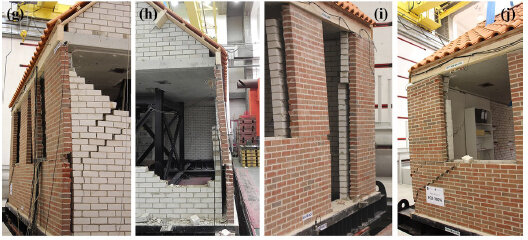TWO‑WAY BENDING OUT‑OF‑PLANE COLLAPSE OF A FULL‑SCALE URm BUILDING TESTED ON A SHAKE TABLE
Bulletin of Earthquake Engineering, 17
Scope and methodology
The upper floor of an URM cavity-wall terraced housewith pitched timber roof was tested in as-built condition using a shake table.
The cavity wall is formed of loadbearing inner leaf of calcium silicate bricks sustaining a reinforced concrete floor and an external leaf made of clay-bricks connected to the inner leaf by means of metallic ties.
Results include damage evolution, hysteretic response, performance of roof structure, identification of global limit states and detailed observed failure mechanism
FINDINGS
The structure exhibited a box-type global response up to hPGA 0.39g with a first structural damage observed at hPGA 0.22g
The observed damage pattern on the longitudinal walls was typical of flexural-rocking behavior.
Despite the large flexibility of the roof system, the partial collapse of the specimen (at hPGA 0.63g) was driven by the out-of-plane failure of the East wall.
Rocking mechanism of the slender longitudinal piers combined with the vertical input motion led to an uplift of the RC slab causing a loss of restraint at the top of the East transverse wall.
At test completion, he RC slab rested on the outer veneer wall with a significant residual displacement (beyond 50 mm).
Furnitures did not show any damage until hPGA 0.39g and vPGA 0.18g. Significant damage occurred at hPGA 0.63g and vPGA 0.34g with overturning of bookshelf not anchored to the wall.





